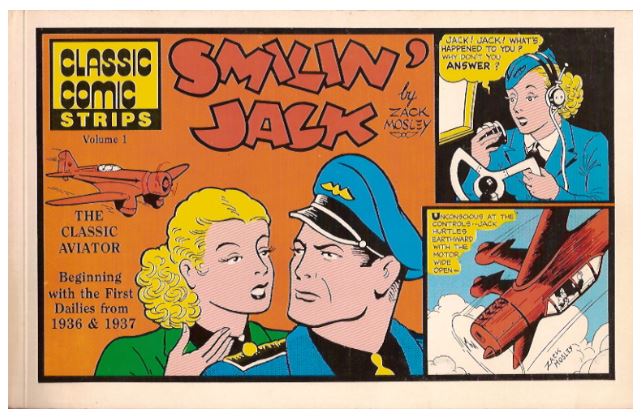
By Zack Mosley (Classic Comic Strips)
No ISBN, no digital editions
Here’s another forgotten birthday boy seriously in need of an archival revival…
Modern comics evolved from newspaper comic strips. Those pictorial features were – until relatively recently – hugely, incredibly popular with the public and highly valued by publishers who used them as an irresistible weapon for guaranteeing and increasing circulation and profits.
It’s virtually impossible for us to understand the overwhelming power of the comic strip in America from the Great Depression to the end of World War II. With no social media or television, broadcast radio far from universal and movie shows at best a weekly treat for most poor to middle-income folk, household entertainment was mostly derived from comic sections in daily and especially Sunday newspapers.
“The Funnies” were the most common and practically communal recreation for millions who were well served by a fantastic variety and incredible quality. From the very start humour was paramount – hence the terms “Funnies” and “Comics” – and from these gag and stunt beginnings came hybrids like Roy Crane’s Wash Tubbs.
Comedic when it began in 1924, it evolved from mock-heroics to light-action to become a full-blown, rip-roaring adventure series with the introduction of prototype swashbuckler Captain Easy in 1929. From there it wasn’t such a leap to full-on action blockbusters like Tarzan (debuting on January 7th 1929) and Buck Rogers (the same day). Both were adaptations of pre-existing prose properties, but the majority of drama strips that followed were original creations.
The tidal-wave began in the early 1930s when an explosion of action/drama strips (tastefully tailored for a family audience and fondly recalled as “Thud and Blunder” yarns by those who read them) were launched with astounding frequency and rapidity.
Not only strips but entire genres were born in that decade, material that still impacts on not just today’s comic books but all our popular fiction. Always most common, however, were and are general feel-good humour strips with an occasional child-oriented fantasy…
Arguably the most welcome of the new adventure genres was the Aviator serial. With air speed, distance and endurance records bring broken every day, travelling air-circuses barnstorming across rural America and real-life heroes like Charles Lindbergh and Amelia Earhart plastered across front pages and in movie newsreels, it wasn’t difficult to grasp the potential of comics strip analogues joining the horde of prose, radio and movie flyers.
The first was Glenn Chaffin & Hal Forrest’s Tailspin Tommy – story of boy pilot Tommy Tompkins. It ran from May 21st 1928 (almost exactly one year after Lindbergh’s epic transatlantic flight in the Spirit of St. Louis) until 1942, and was swiftly followed by both Lester J Maitland & Dick Calkins Skyroads (May 20th 1929, to 1942) and John Terry’s Scorchy Smith which soared from 1930 -1961. Close on their high-flying heels came such late-arriving classics as Flyin’ Jenny, Buz Sawyer and latterly, Steve Canyon.
Zack Mosley was an enterprising young cartoonist who assisted Calkins on both Skyroads and the legendary Buck Rogers in the 25th Century. He was also a dedicated pilot and avaition enthusiast, and when he heard that Captain Joe Patterson (influential editor of The Chicago Tribune) was taking flying lessons, Zack swiftly pitched a series to the kingmaker of comic strips.
On the Wing debuted as a Sunday page on October 1st 1933, but the name never took off and with the December 31st episode the feature was more snappily re-titled Smilin’ Jack. Apparently, Moseley was surreptitiously called “Smiling Zack” around the Tribune office…
The strip steadily gained interest and syndication subscribers and, on June 15th 1936, was augmented by a monochrome daily strip.
Jack Martin was a nervous student pilot, and the series originally played safe by vacillating between comedy and hairsbreadth thrills as he and his fellow unqualified pilots learned the ropes. Never a top-tier series, Smilin’ Jack nevertheless always delivered terrific entertainment to the masses, moving and morphing with the times into a romance, war-feature, crime thriller (complete with Dick Tracy style villains) and even a family soap opera.
More importantly, the strip progressed in real time and when it closed on 1st April 1973, Jack was a twice-married air veteran with a grown son and a full cast of romantic dalliances in tow. It wasn’t lack of popularity that ended it either. At 67 years of age, Mosley wanted to spend his final years in the air, not crouched over a drawing board…
This fabulous (and shamefully scarce) collection gathers a splendid selection of rousing romps, beginning with that name-changing first episode from December 31st 1933, before concentrating on some classic sequences from the roaring Thirties.
Meet here or be reintroduced to Jack, comedy foil Rufus Jimpson (a hillbilly mechanic), eye-candy air hostess and love interest Dixie Lee (subject of an extended romantic triangle), Latin spitfire (the curvy sort, not the fighter plane kind) Bonita Caliente and sundry spies, thugs, imbecilic passengers, South American revolutionaries and even a foreign Legion of the Skies, with an eerily prescient stiff-necked Prussian flyer named Von Bosch whose type would soon be plastered all over strips and comic books once WWII broke out…
This kind of strip is, I suspect and fear, an acquired taste today like films by Preston Sturges, Billy Wilder or George Cukor, requiring the reader contribute a little intellectual and historical concentration, but the effort is absolutely worth it, and if this kind of stuff is good enough for the likes of George Lucas and Steven Spielberg it’s perfectly good enough for you and me…
A grand adventure and one you should definitely undertake if the chance comes. Maybe one day it will even be properly curated and collected for all to re-enjoy…
© 1989, 2009 Chicago Tribune Syndicate. All Rights Reserved. (I’m going on best evidence here: if somebody else actually owns the rights now, let me know and I’ll happily amend the entry).
